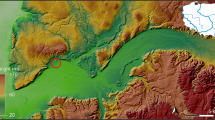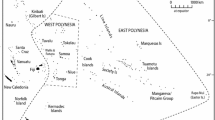Abstract
Grouping techniques employ similarities within data to create new entities, which lend themselves to the interpretation process. This article presents three different grouping approaches, each originally developed independently, and applied to a common dataset of archaeological finds. The aim is not to search for the right approach or results, in a competing way, but rather to present the methods as complementary. It is also our intention to stress that a tight connection between theory and statistical modelling is indispensable. Indeed, the use of a particular methodology must be supported by an adapted theory; similarly, a theory without a proper methodological realisation will often not have any actual utility. The integration of theory and method is exemplified in the three case methods. The first method uses metal objects as cultural indicators. The study area is divided into a set of identical geographical units, characterized according to the type and proportions of indicators and grouped using hierarchical clustering. The second approach deals with cultures as standardisations between individuals, using ‘Typenspektrum’ as significant data for identifying different cultures. Groups are defined through kernel density estimation and a cluster analysis, followed by internal and external validation techniques. A third method characterizes the funerary ritual and grave-goods, using a similarity algorithm coupled with clustering procedures to compare the graves with one another. The outcome is validated with exploratory methods and compared to patterns from different contexts. The complementarity of the results shows that each approach sheds light on a certain facet of the same whole.






Similar content being viewed by others
Notes
The database contains approximately 80,000 finds from circa 12,000 sites dating from Hallstatt C to La Tène B. Twelve thousand nine hundred eighty finds from 215 sites, dating to Hallstatt D, are used in our analyses.
The methods were developed as part of two Ph.D. theses and a post-doctoral dissertation (habilitation) (Nakoinz 2013; Popa forthcoming; Tremblay Cormier 2016).
The excavation procedure and ideas from our present society also have an influence on the archaeological record.
Developed by L. Tremblay Cormier
Voronoi polygons are a space division method, where each polygon corresponds to the catchment area of a point. When using Euclidean metric, the polygon’s limits are set to the middle of the distance between its midpoint and the nearest neighbouring points.
Developed by O. Nakoinz
Figure 2 visualises this effect and is discussed below.
Developed by C. Popa
All the types cited in this article come from the typology of the Heuneburg’s fibulae (Mansfeld 1973, 4–5).
This apparent lack of regional differentiation may also be connected to poor data recording, since in analyses carried out on other datasets, clear regional differences were observable (Popa, 2012, 2014, forthcoming).
There are a countless number of studies on this topic; for the last synthesis, see Krauße and Beilharz (Ed.) 2010.
References
Anderson, B. (1991). Imagined communities: reflections on the origin and spread of nationalism. London: Verso.
Barth, F. (1969). Ethnic groups and boundaries: the social organization of culture difference. Boston: Little, Brown and Co..
Barth, F. (2002). An anthropology of knowledge. Current Anthropology, 43, 1–18.
Biel, J. (1985). Der Keltenfürst von Hochdorf: Methoden und Ergebnisse der Landesarchäologie. Katalog zur Ausstellung. Stuttgart: Konrad Theiss.
Bourdieu, P. (1977). Outline of a theory of practice. Cambridge: Cambridge University Press.
Canuto, M.-A., & Yaeger, J. (2000). Introducing an archaeology of communities. In M.-A. Canuto & J. Yaeger (Eds.), The archaeology of communities: a new world perspective (pp. 1–15). London: Routledge.
del Castillo, F., Barceló, J. A., Mameli, L., Miguel, F., & Vila, X. (2013). Modeling mechanisms of cultural diversity and ethnicity in hunter–gatherers. Journal of Archaeological Method and Theory, 21(2), 364–384.
Clarke, D. L. (1968). Analytical archaeology. New York: Columbia University Press.
Clarke, D. L. (Ed.). (1972). Models in archaeology. London: Methuen.
Collard, M. (2010). Collapse of the pre-pottery neolithic ‘B’ in Southwest Asia. Master’s Thesis Department of Anthropology, Trent University.
Di, H. (2013). Approaches to the archaeology of ethnogenesis: past and emergent perspectives. Journal of Archaeological Research, 21, 371–402.
Díaz-Andreu, M., Lucy, S. (2005). Introduction. What is identity? In: Díaz-Andreu, M., Lucy, S., Babić, S &, Edwards, D. (Eds.), The archaeology of identity: approaches to gender, age, status, ethnicity and religion (pp. 1–12). London: Routledge.
Djindjian, F. (1991). Méthodes pour l’archéologie. Paris: Armand Colin.
Drennan, R. D. (1996). Statistics for archaeologists: a commonsense approach. New York: Plenum.
Ellis, L. (2000). Archaeological method and theory: an encyclopedia. New York: Garland Publishing.
Everitt, B. S., Landau, S., Leese, M., & Stahl, D. (2011). Cluster analysis. Chichester: Wiley.
Gallay, A. (1986). L’archéologie demain. Paris: Pierre Belfond.
Gersbach, E. (1989). Ausgrabungsmethodik und Stratigraphie der Heuneburg. Mainz am Rhein: Philipp von Zabern.
Greenacre, M. J. (1984). Theory and applications of correspondence analysis. London: Academic Press.
Halkidi, M., Batistakis, Y., & Vazirgiannis, M. (2001). On clustering validation techniques. Journal of Intelligent Information Systems, 17(2001), 107–145.
Hall, S. (1996). Introduction: who needs “identity”? In S. Hall & P. du Gay (Eds.), Questions of cultural identity (pp. 1–17). London: Sage.
Hansen, K. P. (2003). Kultur und Kulturwissenschaft. Tübingen: A. Francke.
Harte, J. (1988). Consider a spherical cow: a course in environmental problem solving. Sausalito: University Science Books.
Hartigan, J. A., & Mohanty, S. (1992). The RUNT test for multimodality. Journal of Classification, 9(1992), 63–70.
Hausmair, B. (2015). Am Rande des Grabs. Todeskonzepte und Bestattungsritual in der frühmittelalterlichen Alamannia. Leiden: Sidestone Press.
Hodder, I. (1988). Reading the past: current approaches to interpretation in archaeology. Cambridge: Cambridge University Press.
Hodder, I. (2012). Entangled: an archaeology of the relationships between humans and things. Malden: Wiley-Blackwell.
Jones, S. (1997). The archaeology of ethnicity: constructing identities in the past and present. London: Routledge.
Kimmig, W. (1983). Die Heuneburg an der oberen Donau. Stuttgart: Konrad Theiss.
Krauße, D. (2004). Frühe Zentralisierungs- und Urbanisierungsprozesse. Zur Genese und Entwicklung frühkeltischer Fürstensitze und ihres territorialen Umlandes. Ein Schwerpunktprogramm der Deutschen Forschungsgemeinschaft. Archäologisches Nachrichtenblatt, 9, 359–374.
Krauße, D., & Beilharz, D. (Ed.) (2010). “Fürstensitze” und Zentralorte der frühen Kelten. Abschlußkolloquium des DFG Schwerpunktprogramms 1171. Teil II. Forschungen und Berichte zur Vor- und Frühgeschichte in Baden-Württemberg 120. Stuttgart: Theiss. 317–332.
Latour, B. (1999). Pandora’s hope: essays on the reality of science studies. Cambridge, Mass: Harvard University Press.
Lucy, S. (2005). Ethnic and cultural identities. In M. Díaz-Andreu, S. Lucy, S. Babić, & D. Edwards (Eds.), The archaeology of identity: approaches to gender, age, status, ethnicity and religion (pp. 86–109). London: Routledge.
Madsen, T. (2007). Multivariate data analysis. ArchaeoInfo. http://www.archaeoinfo.dk/PDF%20files/Multivariate%20data%20analysis.pdf. Accessed 28 September 2012.
Mansfeld, G. (1973). Die Fibeln der Heuneburg: ein Beitrag zur Geschichte der Späthallstattfibel. Römisch-Germischen Forschungen 33. Berlin: Walter de Gruyter.
Nakoinz, O. (2005). Studien zur räumlichen Abgrenzung und Strukturierung der älteren Hunsrück-Eifel-Kultur. Universitätsforschung zur Prähistorischen Archäologie 118. Bonn: Habelt.
Nakoinz, O. (2010). Die archäologische Kulturgeographie der ältereisenzeitlichen Zentralorte Südwestdeutschlands: empirische Analysen. Johanna-Mestorf-Akademie. http://www.johanna-mestorf-academy.uni-kiel.de/wordpress/wp-content/uploads/2014/06/Analyseband_screen.pdf. Accessed 14 October 2015.
Nakoinz, O. (2013). Archäologische Kulturgeographie der ältereisenzeitlichen Zentralorte Südwestdeutschlands. Universitätsforschung zur Prähistorischen Archäologie 224. Bonn: Habelt.
Nakoinz, O. (2014). Fingerprinting Iron Age communities in South-West-Germany and an integrative theory of culture. In C. Popa & S. Stoddart (Eds.), Fingerprintig the iron age (pp. 187–199). Oxford: Oxbow Books.
Nakoinz, O. & Knitter, D. (2016). Modelling human behaviour in landscapes. Basic concepts and modelling elements. Quantitative Archaeology and Archaeological Modelling 1. New York: Springer.
Nuninger, L., Saligny, L., Oštir, K., Poirier, N., Fovet, É., Gandini, C., Gauthier, E., Kokalj, Ž., & Tolle, F. (2012). Chapter 1—models and tools for territorial dynamic studies. In C. Gandini, F. Favory, & L. Nuninger (Eds.), Settlement patterns, production and trades from the Neolithic to the Middle Age: Archaedyn. 7 millennia of territorial dynamics. Settlements pattern, production and trades from Neolithic to Middle Ages (pp. 23–37). Oxford: BAR International Series 2370.
Polletta, F., & Jasper, J. M. (2001). Collective identity and social movements. Annual Review of Sociology, 27, 283–305.
Popa, C. N. (2012). Till death do us part. A statistical approach to identifying burial similarity and grouping. The case of the Late La Tène Graves from the Eastern Carpathian Basin. In S. Berecki (Ed.), Iron age rites and rituals in the Carpathian Basin (pp. 401–412). Târgu Mureş: Bibliotheca Musei Marisiensis, Seria Archaeologica Mega.
Popa, C. N. (2014). The quest for group identity in Late Iron Age Romania. Statistical reconstruction of groups based on funerary evidence. In C. N. Popa & S. Stoddart (Eds.), Fingerprinting the iron age (pp. 108–122). Oxford: Oxbow.
Popa, C. N. (forthcoming). Modelling identities: Late Iron Age identity in South-East Europe. New York: Springer.
Robb, J. (2010). Beyond agency. World Archaeology, 42, 493–520.
Sommer, U. (2003). Materielle Kultur und Ethnizität—eine sinnlose Fragestellung ? In U. Veit, T. Kienlin, C. Kümmel, & S. Schmidt (Eds.), Spuren und Botschaften: Interpretationen materieller Kultur (pp. 205–223). Münster: Waxmann.
Sørensen, L. S. (2014). The archaeological culture concept: hot or cold understandings. In H. Alexandersson, A. Andreeff, & A. Bünz (Eds.), Med hjärta och hjärna: En vänbok till professor Elisabeth Arwill-Nordbladh (pp. 247–258). Göteborg: University of Gothenburg.
Tremblay Cormier, L. (2016). Identités culturelles et échanges entre Rhin et Rhône du 10ème au 5ème siècle avant notre ère. Dijon: Éditions Universitaires de Dijon. Art, Archéologie & Patrimoine.
VanPool, T. L., & Leonard, R. D. (2011). Quantitative analysis in archaeology. Chichester: Wiley-Blackwell.
Voss, B. L. (2005). From casta to Californio: social identity and the archaeology of culture contact. American Anthropologist, 107, 461–474.
Voss, B. L. (2008). The archaeology of ethnogenesis: race and sexuality in Colonial San Francisco. Berkeley: University of California Press.
Acknowledgements
Oliver Nakoinz is grateful to the Deutsche Forschungsgemeinschaft (DFG) for supporting this work with a Heisenberg fellowship (NA 687/1-1, NA 687/1-2) and to Dirk Krauße, Johannes Müller und Ulrich Müller for the opportunity to participate in the project ‘Siedlungshierarchien und kulturelle Räume’ in the DFG priority project 1171.
Cătălin Popa expresses his gratitude to the Dahlem Research School and the Excellence Cluster TOPOI for housing and funding his research.
Laurie Tremblay Cormier would like to thank the Université de Bourgogne and the Ministère de la Culture for hosting and funding her Ph.D. research.
Funding
The original analysis of approach two was funded by DFG (grand number KR 1753/2-3) while the integration of this approach into this study was funded by a DFG Heisenberg fellowship (grant number NA 687/1-1, NA 687/1-2).
Author information
Authors and Affiliations
Corresponding author
Ethics declarations
Conflict of Interest
The authors declare that they have no conflict of interest.
Rights and permissions
About this article
Cite this article
Tremblay Cormier, L., Nakoinz, O. & Popa, C.N. Three Methods for Detecting Past Groupings: Cultural Space and Group Identity. J Archaeol Method Theory 25, 643–661 (2018). https://doi.org/10.1007/s10816-017-9350-2
Published:
Issue Date:
DOI: https://doi.org/10.1007/s10816-017-9350-2




